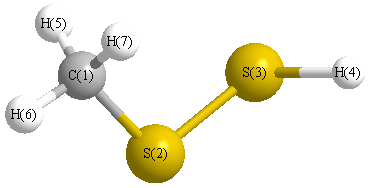Vibrational Frequencies calculated at TPSSh/cc-pVDZ
| Mode Number |
Symmetry |
Frequency
(cm-1) |
Scaled Frequency
(cm-1) |
IR Intensities
(km mol-1) |
Raman Act
(Å4/u) |
Dep P |
Dep U |
|---|
| 1 |
A |
3155 |
3067 |
7.23 |
65.49 |
0.75 |
0.86 |
| 2 |
A |
3137 |
3051 |
6.34 |
103.47 |
0.74 |
0.85 |
| 3 |
A |
3037 |
2954 |
20.10 |
175.22 |
0.02 |
0.04 |
| 4 |
A |
2610 |
2537 |
13.22 |
189.76 |
0.27 |
0.43 |
| 5 |
A |
1466 |
1426 |
8.37 |
12.38 |
0.74 |
0.85 |
| 6 |
A |
1447 |
1407 |
7.60 |
15.59 |
0.75 |
0.86 |
| 7 |
A |
1322 |
1286 |
7.98 |
2.68 |
0.35 |
0.52 |
| 8 |
A |
960 |
934 |
6.66 |
4.37 |
0.52 |
0.68 |
| 9 |
A |
956 |
929 |
3.56 |
4.31 |
0.70 |
0.82 |
| 10 |
A |
864 |
840 |
4.11 |
27.48 |
0.63 |
0.77 |
| 11 |
A |
682 |
663 |
2.21 |
12.53 |
0.27 |
0.42 |
| 12 |
A |
497 |
483 |
0.97 |
11.62 |
0.27 |
0.42 |
| 13 |
A |
336 |
327 |
16.64 |
13.79 |
0.75 |
0.86 |
| 14 |
A |
233 |
226 |
0.32 |
5.93 |
0.61 |
0.76 |
| 15 |
A |
166 |
161 |
0.53 |
0.01 |
0.73 |
0.85 |
Unscaled Zero Point Vibrational Energy (zpe) 10433.3 cm
-1
Scaled (by 0.9724) Zero Point Vibrational Energy (zpe) 10145.3 cm
-1
See section
III.C.1 List or set vibrational scaling factors
to change the scale factors used here.
See section
III.C.2
Calculate a vibrational scaling factor for a given set of molecules
to determine the least squares best scaling factor.
Charges, Dipole, Quadrupole and Polarizability
Charges from optimized geometry at TPSSh/cc-pVDZ
Charges (e)
| Number |
Element |
Mulliken |
CHELPG |
AIM |
ESP |
| 1 |
C |
-0.144 |
|
|
|
| 2 |
S |
-0.086 |
|
|
|
| 3 |
S |
-0.112 |
|
|
|
| 4 |
H |
0.106 |
|
|
|
| 5 |
H |
0.083 |
|
|
|
| 6 |
H |
0.077 |
|
|
|
| 7 |
H |
0.075 |
|
|
|
Electric dipole moments
Electric dipole components in Debye
(What's a Debye? See section
VII.A.3)
| |
x |
y |
z |
Total |
| |
-1.013 |
1.248 |
0.902 |
1.843 |
| CHELPG |
|
|
|
|
| AIM |
|
|
|
|
| ESP |
|
|
|
|
Electric Quadrupole moment
Quadrupole components in D Å
Polarizabilities
Components of the polarizability tensor.
Units are
Å
3 (Angstrom cubed)
Change units.
| |
x |
y |
z |
| x |
9.107 |
0.326 |
0.259 |
| y |
0.326 |
5.645 |
0.129 |
| z |
0.259 |
0.129 |
4.959 |
<r2> (average value of r
2) Å
2
| <r2> |
103.799 |
| (<r2>)1/2 |
10.188 |
